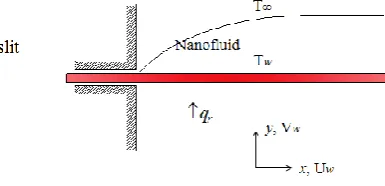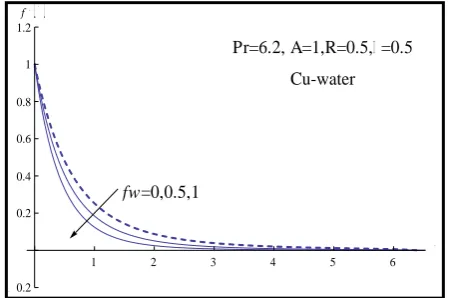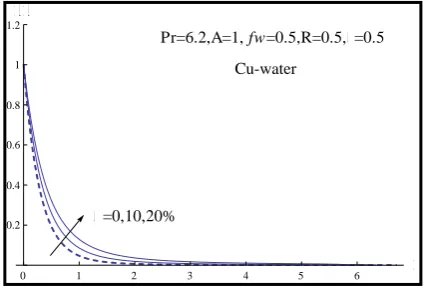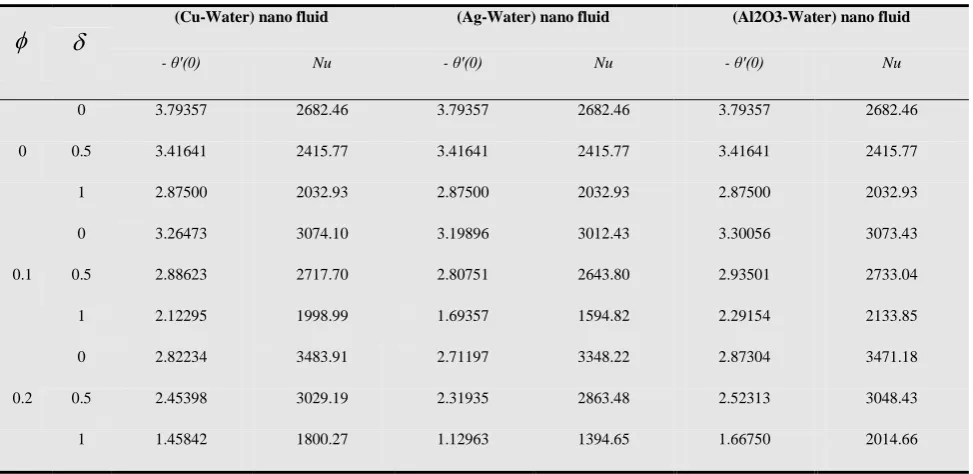DETERMINATION OF VELOCITY AND TEMPERATURE IN
AN UNSTABLE SURFACE
F. R. KENNEDY
DEPARTMENT OF MATHEMATICS UNIVERSITY OF BOTSWANAT. G. KIUNA
DEPARTMENT OFMATHEMATICS UNIVERSITY OF BOTSWANA
N. B. OKELO
SCHOOL OF MATHEMATICS AND ACTUARIAL SCIENCE, JARAMOGI OGINGA ODINGA
UNIVERSITY OF SCIENCE AND TECHNOLOGY,
KENYA
ABSTRACT
In this paper we formulate equations that are solvable numerically to determine the velocity and temperature in an unstable surface
General Terms
Unsteady Motion, Heat Generation, Thermal Radiation.
1.
INTRODUCTION
Nanofluid is described as a fluid in which solid nanoparticles with the length scales of 1-100 nm are suspended in conventional heat transfer basic fluid. These nanoparticles enhance thermal conductivity and convective heat transfer coefficient of the base fluid significantly. Conventional heat transfer fluids such as oil, water and ethylene glycol mixture are poor heat transfer fluids because the thermal conductivity affects the heat transfer coefficient between the heat transfer medium and the heat transfer surface. Therefore numerous methods have been taken to improve the thermal conductivity of these fluids by suspending nano/micro sized particle materials in liquids. The term nanofluid refers to fluids in which nano-scale particles are suspended in the base fluid and it has been suggested by Choi [19]. There are many studies on the mechanism behind the enhanced heat transfer characteristics using nanofluids. The collection of papers on this topic is included in the book by Das et. al. [20] and in the review papers by Azizah etal. [21], Aminreza et al. [22], Nazar et al. [23] and Hamad [24], Oztop etal.[25] and Yacob etal. [26].
2.
FORMULATION OF THE PROBLEM
Consider an unsteady, laminar, and incompressible nanofluid on a continuous moving surface. The fluid is a water based nanofluid containing three type of nanoparticles, either Cu (Copper) or Ag (Silver) or Al2O3 (Aluminum oxide). The nanoparticles are assumed to have a uniform shape and size. Moreover, it is assumed that both the fluid phase and nanoparticles are in thermal equilibrium state. As shown in fig. (1) the x-axis runs along the surface, and the y-axis is perpendicular to it.
Fig (1). physical model and coordinate system. The conservation equations for the unsteady boundary layer are
0 y v x u (1) 2 2 y u y u v x u u t u nf nf (2)
yq c c T T Q y T y T v x T u t T r nf p nf p nf 1 2 2 (3)
Subjected to the boundary conditions
asy
T T v u y at T T v v U
u w w w
, , 0 , 0 0 , , , (4)
dynamic viscosity,
nf is the density of the nanofluid, T is the temperature of the nanofluid,
nf is the thermaldiffusion of the nanofluid, Q is the heat source or sink,
C
pspecific heat of the nanofluid, T is the temperature of thenanofluid,
T
w is the surface temperature, andT
is ambient temperature, andq
r is the radiative heat flux.The fluid is considered to be gray, absorbing-emitting radiation but non-scattering medium and the Rosselond approximation is used to describe the radiative heat flux in the energy equation (3). By using Rosseland approximation for radiation radiative heat flux is simplified as
y T
qr
4 3 4
(5)
Where σ and α are the Stefen-Boltzman constant and the mean absorption coefficient respectively. assuming that the
temperature differences within the flow are such that the term T4 may be expressed as a linear function of temperature.
Hence, expandingT4 in a Taylor series about
T and neglecting higher order terms we get
4 3
4 4 3
TT T
T (6)
Using equation (5) and (6) in the energy equation (3) becomes
T T c Q y T c T y T y T v x T u t T nf nf nf p p 2 2 3 2 2 3 16 (7)
It is assumed that the velocity of the surface
U
w and the surface temperatureT
w are of the form
t
bx T t x T t ax t x
Uw w 1 ) , ( , 1 ) , ( (8)
Where a, b and γ are constants. The properties of nanofluid are defined as follows (see [16]).
p nfnf nf s f nf . f nf C k , , 1
1 25
s f f s s f f s f nf s p f p nf p k k k k k k k k k k , C C C 2 2 2 1where
is nanoparticle volume fraction, it is worth mentioning that the study reduces to those of a viscous or regular fluid when (
=0).We look for similarity solution of eqs (1,2,and 7) subjected to the boundary conditions (4) of the following form
T T T T f x t a y t a w f f , 1 , 1 (9)where η is the similarity variable and θ is the dimensionless temperature,
f is the kinamatic viscosity of the base(water), and
is the stream function, which defined asx v y u
(9) into eqs. (2) and (7) we obtain
0 2
1 2
f f A f f f f B (10) 0 2 3 4 A f f R L pr (11)
The boundary condition (4) become
0
f
,
f
0
1
0
1
f
wand
0
,
0
f
(12) where
f p s p f nf f p s p f s C C k k L and C C B 1 1 , 11 2.5
,
a
A
is the unsteadiness parameter ,
f
k
T
R
34
is the radiation parameter,
U
w
c
px
Q
is the heat source parameter and f p r k C p
is the prandtl
number, f
w a t V fw 1
is the suction/injection parameter
3.
NUMERICAL SOLUTIONS AND RESULTS
We first convert the Equations (10) and (11) to a system of differential equations of first order, by using
2 3 4 51
f
,
S
f
,
S
f
,
S
,
S
S
4 5 2 1 4 5 1 4 2 5 5 4 3 2 1 2 3 1 2 2 3 3 2 2 1 3 4 3 S S S A S S S S L R p S S S S S A S S S B S S S S Sr
(13)
Subjected to the initial conditions
fw S
S
m S
S
nS1 0 , 2 0 1, 3 0 , 4 0 1, 50 (14)
Using mathematica, a function (F) has been defined such that F [m, n]:=NDSolve [system (13),(14)], The value of m and n are determined upon solving the equations, S2(max) =0, and S4(max) =0 to get the solution, NDSolve first searches for initial conditions that satisfy the equations, using a combination of Solve and a procedure much like Find Root. once m and n are determined the system (13) and (14) is closed, it can be solved numerically using the NDSolve function.
Fig (1). The Velocity profiles with increasing of unsteadiness parameter (A).
Fig (2). The Temperature profiles with increasing of unsteadiness parameter (A).
Fig (3). The Velocity profiles with increasing of suction parameter (fw).
Pr=6.2, fw=0.5,R=0.5, =0.5
Cu-water
A=1, 2, 3
0 1 2 3 4
0.2 0.4 0.6 0.8 1 1.2
f
Pr=6.2, fw=0.5,R=0.5, =0.5
Cu-water
A=1, 2, 3
0 1 2 3 4
0.2 0.4 0.6 0.8 1 1.2
Pr=6.2, A=1,R=0.5, =0.5
Cu-water
fw=0,0.5,1
1 2 3 4 5 6
0.2 0.2 0.4 0.6 0.8 1 1.2
Fig (4). The Temperature profiles with increasing of suction parameter (fw).
Fig (5). The Velocity profiles with increasing of nanoparticle volume fraction (
).Fig (6). The Temperature profiles with increasing of nanoparticle volume fraction (
). fw=0,0.5,1Pr=6.2, A=1,R=0.5, =0.5
Cu-water
1 2 3 4 5 6
0.2 0.2 0.4 0.6 0.8 1 1.2
Pr=6.2,A=1, fw=0.5,R=0.5, =0.5
Cu-water
=0,10,20%
0 1 2 3 4 5 6
0.2 0.4 0.6 0.8 1 1.2
f
Pr=6.2,A=1, fw=0.5,R=0.5, =0.5
Cu-water
=0,10,20%
0 1 2 3 4 5 6
Fig (7). The Temperature profiles with increasing of radiation parameter (R).
Fig (8). The Temperature profiles with increasing of heat source parameter (
).Table (1). Thermophysical properties of water and the elements Cu, Ag and Al2O3.
Properties fluid (water) Cu Ag Al2O3
Cp (j/kgK) 4179 385 235 765
ρ (kg/m³) 997.1 8933 10500 3970
K (W/mK) 0.613 400 429 40
To validate the numerical method used in this study, the case of (A =0,R= 0,
0
and
=0) was considered in table (2) and the results for -θ'(0) are compared with the numerical solution which reported in Ishak et a.l [18]. Also the values of -f ''(0) at steady state are compared with the analytical solution which reported in Hamad [24] in table (3).R=0,0.2,0.6
Pr=6.2, A=1,fw=1, =0.5 Cu-water
1 2 3
0.2 0.2 0.4 0.6 0.8 1 1.2
Pr=6.2, A=1,fw=1,R=0.5
Cu-water
=0,0.5,1
1 2 3
Table (2). Values of - θ'(0) for a various values of (fw) and Pr at A=0, R =0 ,
0
,
=0.Pr Fw Ishak et al [18] present results
1
-1.50 0.50000 0.50000
-1.50 0.64520 0.64516
10
1.50 2.00000 2.00000
1.50 16.08420 16.08422
Table (3). Values of - f ''(0) for a various values of (
) at Pr=6.2, A=0,R=0,
0
, fw=0 for Cu- nanoparticles.
Hamad [24] present results0.05 1.10892 1.10892
0.1 1.17475 1.17474
0.15 120886 1.20888
0.2 1.21804 1.21804
From the engineering point of view, the most important characteristics of the flow are the skin friction coefficient, and Nusselt number which are indicate physically to surface shear stress, and rate of heat transfer respectively. This characteristics effect directly on the mechanical properties of the surface during heat treatment process, such that increasing the rate of heat transfer from the surface accelerates the cooling of the surface which improve the hardness and shear strength of the surface but on the other hand decrease the ductility of the surface and increase surface cracking.
a) surface shear stress
01 1 2.5
0
f t a U
y u
f w f
y nf
w
since the skin friction coefficient is given by
2
2
w w f
U C
i.e
.C
fR
ef
5 2
1
0
2
b) surface heat flux
0
1
0
t
a
T
T
k
y
T
k
q
f w
nf y
nf w
since the Nusselt number is given by
T
T
k
xq
Nu
w f
w
i.e
0
f nf
e k
k
Table (3). values of velocity gradient and temperature gradient at the surface at
=0.1,
=0.5, Pr = 6.2.A fw R
(Cu-Water) nano fluid (Ag-Water) nano fluid (Al2O3-Water) nano fluid
- f ''(0) - θ'(0) Cfx Nu - f ''(0) - θ'(0) Cfx Nu - f ''(0) - θ'(0) Cfx Nu
1 -1
0 1.04967 1.13491 0.00386 1068.65 1.07770 1.11793 0.00397 1052.74 0.94324 1.14154 0.00347 1062.98
0.6 1.04967 1.01620 0.00386 956.87 1.07770 0.99903 0.00397 940.78 0.94324 1.02367 0.00347 953.23
1.2 1.04967 0.92873 0.00386 874.50 1.07770 0.91176 0.00397 858.60 0.94324 0.93658 0.00347 872.13
1
0 2.34079 5.72400 0.00862 5389.77 2.48324 5.58073 0.00914 5255.31 1.87330 5.78023 0.00690 5382.46
0.6 2.34079 3.81709 0.00862 3594.21 2.48324 3.71360 0.00914 3497.06 1.87330 3.86362 0.00690 3597.74
1.2 2.34079 2.91084 0.00862 2740.88 2.48324 2.82628 0.00914 2661.48 1.87330 2.95685 0.00690 2753.37
2 -1
0 1.35502 1.69361 0.00499 1594.72 1.39471 1.67384 0.00513 1576.24 1.20673 1.70027 0.00444 1583.27
0.6 1.35502 1.48878 0.00499 1401.85 1.39471 1.46938 0.00513 1383.70 1.20673 1.49483 0.00444 1391.96
1.2 1.35502 1.34729 0.00499 1268.62 1.39471 1.32854 0.00513 1251.07 1.20673 1.35296 0.00444 1259.85
1
0 2.61086 6.09234 0.00961 5736.61 2.76191 5.95168 0.01017 5604.64 2.11101 6.14051 0.00777 5717.95
0.6 2.61086 4.16970 0.00961 3926.23 2.76191 4.07156 0.01017 3834.15 2.11101 4.20170 0.00777 3912.56
1.2 2.61086 3.25502 0.00961 3064.96 2.76191 3.17741 0.01017 2992.13 2.11101 3.28247 0.00777 3056.58
Table (4). values of velocity gradient and temperature gradient at the surface at fw=0.5,R=0.5,A=1, Pr = 6.1.
(Cu-Water) nano fluid (Ag-Water) nano fluid (Al2O3-Water) nano fluid- θ'(0) Nu - θ'(0) Nu - θ'(0) Nu
0
0 3.79357 2682.46 3.79357 2682.46 3.79357 2682.46
0.5 3.41641 2415.77 3.41641 2415.77 3.41641 2415.77
1 2.87500 2032.93 2.87500 2032.93 2.87500 2032.93
0.1
0 3.26473 3074.10 3.19896 3012.43 3.30056 3073.43
0.5 2.88623 2717.70 2.80751 2643.80 2.93501 2733.04
1 2.12295 1998.99 1.69357 1594.82 2.29154 2133.85
0.2
0 2.82234 3483.91 2.71197 3348.22 2.87304 3471.18
0.5 2.45398 3029.19 2.31935 2863.48 2.52313 3048.43
4.
DISCUSSIONS
We present in this study a mathematical model of a moving continuous surface embedded into a nanofluid. The
influence of thermal radiation (R), heat source (
),suction/injection (fw), nanoparticles type, and nanoparticle volumefraction (
),and the unsteadiness parameter (A) on the velocity and temperature within the boundary layer are shown in figures (1-8). We consider three different types of nanoparticles, Cu, Ag and Al2O3 with water as the base fluid. Table (1) shows the thermophysical properties of water and the elements Cu, Ag and Al2O3. The prandlt number of the base fluid (water) is kept constant at 6.2,The effect of unsteadiness parameter (A) on the velocity and temperature within the boundary layer of (Cu-nanofluid) are shown in figures (1&2) It is observed that the velocity and temperature within the boundary layer decreases with increase of the unsteadiness parameter. also increase the unsteadiness parameter decrease the boundary layer thickness
Figures (3) and (4) show the effect of suction/injection parameter on the velocity and temperature within the boundary layer of Cu-nanofluid respectively. It is observed that the increases of suction/injection parameter decrease both the velocity and temperature within the boundary layer.
The effect of nanoparticles concentration (volume fraction) (
) on the velocity and temperature within the boundary layer of Cu- nanofluid are shown in figures (5&6). It is observed that increases of nanoparticle volume fraction decrease the velocity but increase the temperature within the boundary layer.The effect of thermal radiation parameter (R) and heat source parameter (
) on the temperature within the boundary layer of (Cu-nanofluid) are shown in figures (7&8) respectively. It is observed that increase the thermal radiation and heat source increase the temperature within the boundary layer.Table (3&4) show the values of velocity gradient and temperature gradient at the surface and the corresponding values
of skin friction and Nusselt number for different values of (A), (fw), and (R) at
R
e
5
x
10
5. The effect of Nanoparticlestype, nanoparticle concentration, steady and unsteady motion, suction and injection, and thermal radiation, heat generation on surface shear stress, surface heat flux and the mechanical properties (hardness, stiffness, strength, surface cracking, etc.) are discussed below.
A. type of nano particles
It is clear from table (3) that the values of velocity gradient at the surface increased gradually by changing the nanoparticle from Al2O3 to Cu to Ag. but the opposite effect occurs on temperature gradient. on the other hand the skin friction and surface shear stress are higher in the case of Ag-nanofluid than that in Cu and Al2O3-nanofluid, also the Nusselt number and rate of heat transfer from the surface are higher in the case of Cu-nanofluid than that in Al2O3 and Ag-nanofluid, which means that using Cu-nanofluid as a cooling medium is more useful for the surface hardness and strength.
B. concentration of nano particle within the base fluid
Table (4) shows that the values of velocity gradient at the surface increase gradually by increase the particle volume fraction from 10% to 20% in the case of Cu and Ag-nanoparticle and decrease for Al2O3 nanoparticle, But the temperature gradient decreases by increase of it for all types of Nanoparticles.
On the other hand the skin friction and Nusselt number both increase with increase of the concentration of nanoparticle within the base fluid. But in the presence of heat source the effect of nanoparticle concentration may be reversed such that increase the heat source parameter decrease the Nusselt number.
In general using a nanofluid in the cooling process is more active to improve the mechanical properties of the surface, such that using nanofluid increase the rate of heat transfer by (10-40%) more than in the case of pure water that leads to accelerate the cooling of the surface which increase the surface hardness and strength.
C. steady and unsteady motion
unsteadiness parameter increase the velocity gradient, skin friction, and surface shear stress also increase the temperature gradient, Nusselt number, and rate of heat transfer. it is worth mentioning that increasing the unsteadiness parameter from 1 to 2 increases the Nusselt number by 6% in the case of suction and by 40% in the case of injection for all types of Nanoparticles.
D. suction and injection process
one can say that the suction/injection process play an important role in the cooling process, such that in the case of suction the velocity gradient, skin friction, surface shear stress, temperature gradient, Nusselt number and rate of heat transfer all are higher than that in the case of injection. As we know from previous the increase the rate of heat transfer from the surface improve the mechanical properties of surface.
E. Thermal radiation and heat generation
One can observe that increasing the thermal radiation and heat source both decrease the values of Nusselt number and rate of heat transfer that means the hardness and the strength of the surface will be decrease in the presence of both parameters .
5.
REFERENCES
[1] Schlichting H., Boundary layer theory, 6thedn. McGraw-hill, New Yourk, 1968.
[2] Sakiadis, B.C. Boundary layer behavior on a continuous solid surface. AIChE 1961, 7:26-28.
[3] Crane, L.J. Flow past a stretching plate. Zeitschrift fur Angewandte Mathematik und physic 1970,21:645-647.
[4] Grubka,K. M. Bobba, Heat transfer characteristics of a contuous stretching surface with variable temperature, (ASME) Journal of Heat Transfer, 107 (1985), pp 248-250.
[5] Gupta P.S. and Gupta A.S. Heat and mass transfer on a stretching sheet with suction or blowing. Can. J. Chem. Eng. 55,744-746,1977.
[6] Banks, W.H.H. Similarity solution of the boundary layer equation for a stretching wall. J. Mech. Theory Appl., 2,375-392-1983.
[7] Ali M.E. On thermal boundary layer on a power law stretched surface with suction or injection. Int. J. Heat Mass Flow, 16,280-290,1995.
[8] Elbashbeshy E.M.A, Heat transfer over a stretching surface with variable heat flux. J. phys. D, phys, 31, 1951-1955, 1998.
[9] Elbashbeshy E.M.A., and Bazid M.A.A. the effect of temperature dependent viscosity on heat transfer over continuous moving surface. J. phys. D, phys, 33, 2721, 2000.
[10] Elbashbeshy E.M.A., and Bazid M.A.A. . Heat transfer in a porous medium over a stretching surface with internal heat generation and suction or injection. Appl Math. Coput. 158(3), 799-807,2004.
[11] Elbashbeshy E.M.A.,and Bazid M.A.A. . Heat transfer over a stretching surface with internal heat generation. Can. J. Phys. 81:699-703.
[12] Elbashbeshy E.M.A.,and Bazid M.A.A. Heat transfer over a continuously moving plate embedded in non-darcian porous medium. Int. J. Heat Mass Transfer, 43,3087-2092,2000.
[14] Anderson H.T., Aarsth J.B., and Dandapat B.S., Heat transfer in a liquid film on an unsteady stretching surface. Int. J. Heat Transfer 43, 69-74, 2000.
[15] Elbashbeshy E.M.A.,and Bazid M.A.A. Heat transfer over an unsteady stretching surface. Heat Mass Transfer, 41,1-4,2004.
[16] Elbashbeshy E.M.A.,and Bazid M.A.A. Heat transfer over an unsteady stretching surface with internal heat generation. Appl. Math and Computations. 138(3), 239-245,2003.
[17] Nazar R., Amin N., Pop I. and Flip D. Unsteady boundary layer flow in the region of the stagnation point on a stretching sheet. Int. J. Eng. Sci. 42,1241-1253,2004.
[18] Ishak A, Nazar R., and Pop I. Heat transfer over an unsteady stretching permeable surface with prescribed wall temperature.Nonlinear Analysis: Real World Application 10: 2909-2913, 2009.
[19] Choi S.U.S., Enhancing conductivity of fluids with Nanoparticles, ASME Fluid Eng. Division, 231,99-105,1995.
[20] Das, S.K., Choi, S.U.S., Yu, W. and Pradeep, T. Nanofluids: Science and Technology NJ:Wiley; 2007.
[21] Azizah M., Syakila A., Pop I., Flow and heat transfer over an unsteady shrinking sheet with suction in nanofluids. Int. J. Heat and Mass Transfer,2011.
[22] Aminreza N., Rashid P., and Mohamed G. Effect of partial slip boundary condition on the flow and heat transfer of nanofluids past stretching sheet prescribed constant wall temperature. Int. J. of thermal Sci., 1-9,2012.
[23] Nazar R., Tham L. and Pop I., Mixed convection boundary layer flow from a horizontal circular cylinder embedded in a porous medium filled with a nanofluid, Tranp. Porous med., 86, 517-536, 2011.
[24] M. Hamad, Analytical solution of natural convection flow of Nanofluid over a linearly stretching sheet in the presence of magnetic field. International communications in heat and mass transfer 38, 487-492, 2011.
[25] Oztop H. F., Abu Nada E., Numerical study of natural convection in partially heated rectangular enclosures filled with nanofluids, Int. J. Heat Fluid Flow, 29,1326-1336,2008.





